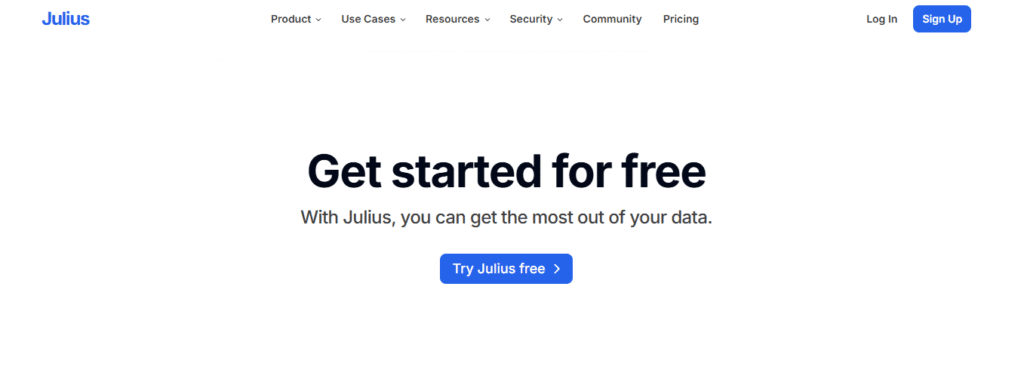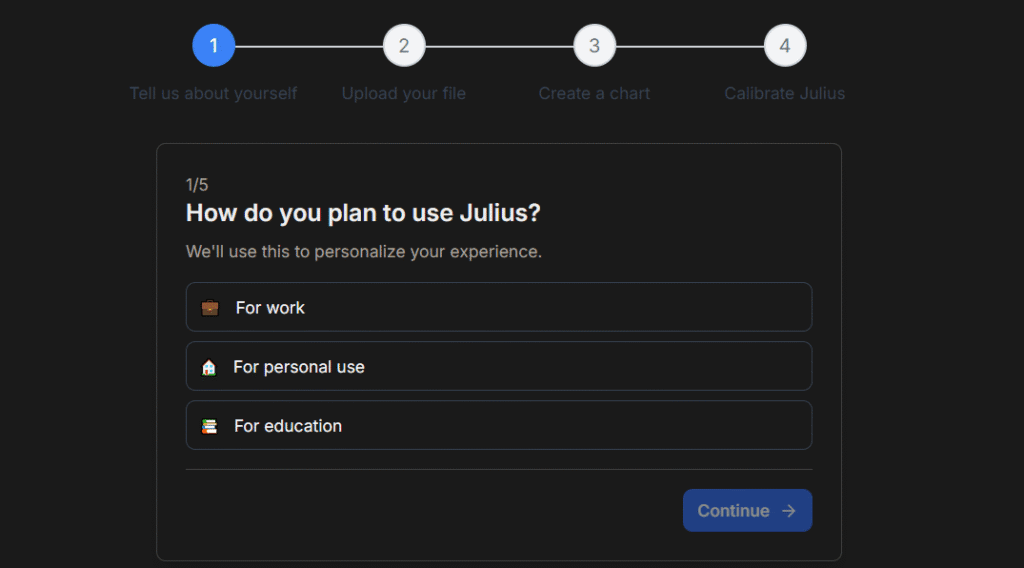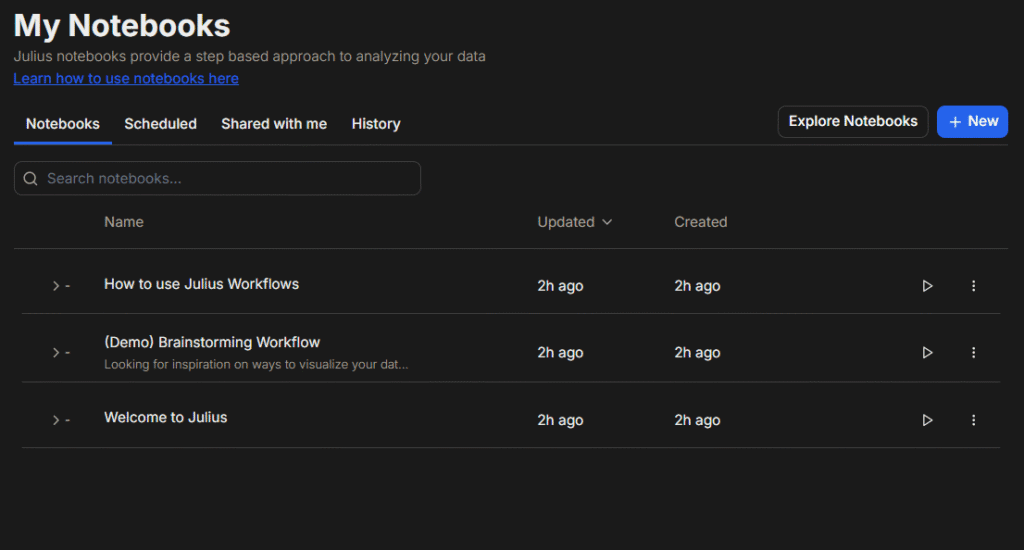Ever spent hours battling stubborn Excel formulas or debugging messy scripts?
With Julius AI, you can simply upload your data and start asking questions in plain English. No coding headaches, no spreadsheet chaos.
In this guide, we’ll walk you through Julius AI.
Whether you’re a beginner or a data pro, you’ll find something useful here.
What Is Julius AI?
Julius AI is an AI data assistant that makes data analysis as easy as having a conversation. Instead of writing complex formulas or code, you simply chat with Julius and it handles the heavy lifting.
From exploring datasets to creating visuals, it turns raw numbers into clear, actionable insights.
How It Works
Getting started is simple:
- Upload your files whether they’re Excel spreadsheets, CSV files, PDFs, Google Sheets, or even images containing data.
- Ask in plain English as type your question or request, and Julius will analyze, summarize, and visualize your data.
- Go deeper with notebooks for advanced users, Julius allows building interactive notebooks for charts, modeling, and more complex analysis.

Want to Supercharge Excel with AI? Check Out the Top Tools for Smarter Data WorkflowsWho Should Use Julius AI
Julius AI is built for anyone who works with data but doesn’t want to waste hours on manual processing or code debugging. It’s especially useful for:
- Data analysts who need quick answers without tedious scripting.
- Educators preparing visual and interactive content for teaching.
- Researchers looking to quickly test hypotheses and explore datasets.
- Marketers tracking campaign results and performance trends.
Julius AI is here for every job:

Julius AI Login: How to Access Your Account
Logging into Julius AI is quick and simple, whether you’re using it for the first time or returning to an ongoing project.
Step-by-Step Login Guide
- Go to the Official Julius AI Website
Visit julius.ai in your browser.

- Click on “Login”
The Login button is usually located in the top-right corner of the homepage.

- Choose Your Login Method
Email & Password: Enter your registered email and password.
Google Login: Sign in instantly using your Google account.

- Access Your Dashboard
Once logged in, you’ll be taken to your main workspace, where you can upload files, create notebooks, and start analyzing data.

Troubleshooting Login Issues
Forgot Password? Click “Forgot Password” on the login page to reset it via email.
New User? Click “Sign Up” instead of “Login” to create a new account.
Browser Issues? Clear cache/cookies or try logging in with an incognito window.
Key Features of Julius AI
Julius AI is a full-fledged AI data assistant packed with tools to make analysis faster, smarter, and more intuitive. Here’s what makes it stand out:
1. Notebooks: Reusable Data Workflows
Julius lets you build interactive notebooks that combine prompts, file inputs, and even code snippets into a single reusable workflow.

This means you can save time by reusing your analysis setup for similar projects, making it ideal for recurring reports or multi-step processes.
“The notebook feature saved me from repeating the same analysis every month. Huge time-saver.”
Data analyst on a forum
2. Visualizations & Insights on Demand
Need a chart, graph, or forecast? Julius can instantly generate:
- Trend analysis to spot patterns
- Forecasting models to predict future outcomes
- Storytelling visuals that make your data presentation ready

3. Data Cleaning & Modeling Without Code
Messy data?
Julius can automatically handle preprocessing, missing values, and statistical modeling all through plain language prompts. No need to touch Python, R, or SQL unless you want to.
4. Automated Workflows for EDA
Automate your Exploratory Data Analysis (EDA) across different datasets. Julius remembers your preferences, so repetitive tasks like summary statistics, correlation checks, and basic visualizations become one-click actions.
5. Multi-Model AI Integration
Under the hood, Julius uses the best of AI that integrating GPT, Claude, and statistical logic engines. It automatically picks the right model for the task, ensuring accuracy whether you’re summarizing text, crunching numbers, or running predictions.
6. Compute Customization for Big Data
Working with huge datasets?
Julius allows you to scale up RAM and computing resources on demand, so heavy workflows run smoothly without crashes or slowdowns.
“I turned a messy 12-tab Excel file into a clean report in under 10 minutes. No scripts, no stress.”
Reddit user
Julius AI Alternatives
If Julius AI doesn’t fully fit your workflow or budget, here are some other AI tools worth checking out:
1. ChatGPT (with Advanced Data Analysis)
Great for general AI tasks and basic data analysis. You can upload files, run calculations, and create charts but you’ll need to know some prompts or code for complex tasks.
2. Microsoft Copilot (Excel & Power BI)
Perfect for heavy Excel or Power BI users. It integrates directly into Microsoft tools, helping with formulas, pivot tables, and visualizations.
3. Rows AI
A spreadsheet platform with built-in AI. Lets you query and transform data directly inside an online spreadsheet interface.
4. Dataiku
An enterprise level tool for machine learning, dashboards, and advanced analytics. More complex than Julius AI, but very powerful for large teams.
5. Akkio
Focused on no-code AI for data analysis and predictive modeling. Great for sales forecasts and marketing data.
6. MonkeyLearn
Specializes in text analysis (sentiment, keyword extraction, classification). Good for survey data or customer feedback analysis.
Tip:
If you want quick, chat-style data insights then Julius AI or ChatGPT ADA works best. If you want deeper integration into spreadsheets and BI tools, go for Microsoft Copilot or Rows AI.
Julius AI vs. ChatGPT & Other AI Tools
| Feature | Julius AI | ChatGPT (with Advanced Data Analysis) | Other AI Tools |
| File Uploads | Works with Excel, CSV, PDF, Google Sheets, and even images | Limited formats often need extra steps | Varies by tool |
| Charts & Visuals | Built-in chart and graph generation | Can make charts but usually needs coding | Some tools have built-in visuals |
| Reusable Workflows | Yes notebooks and automated workflows | No each chat starts fresh | Some have templates, not always reusable |
| Speed & Scalability | Can add more RAM for big datasets | Fixed limits | Depends on the plan |
| Statistics & Modeling | Built-in just ask for results | Requires more manual setup | Varies by tool |
| Best For | People who want quick, no-code data analysis | General AI use and light analysis | Specialized tasks like BI dashboards or ML |
In short:
- Choose Julius AI if your main goal is to quickly analyze and visualize data without touching code.
- Choose ChatGPT if you need a flexible AI for many tasks, not just data.
- Choose other tools if you need deep integration into enterprise BI systems or specialized analytics.
If you deal with a lot of data and want quick insights without coding, Julius AI is faster and easier than general AI tools.
Ready for the Next Generation of AI for data handling? Dive into ChatGPT 5 Features and Access Now!
Curious About Agent Mode?
Learn How ChatGPT Is Becoming More Autonomous Than Ever!
Pricing & Plans of Julius AI
Three plans are here to get Julius AI reach:
- Free Plan: 15 messages per month with access to advanced AI features.
- Pro Plan: Higher message limits, more memory, and the ability to schedule notebooks.
- Student Discount: 50% off for educational users.

Pros & Cons of Julius AI
| Pros | Cons |
| Easy, chat-based data analysis No coding required. | Limited connections to non-data platforms. |
| Can save and reuse workflows Perfect for repeating tasks. | Web scraping and some niche models are still in progress. |
| Adjustable computing power for faster results and handling big datasets. | May be expensive for very small budgets. |
Real-World Use Cases
It’s used by everyone as sees the real user:

1. Business Analytics
Easily analyze sales data, track conversion rates, and measure product performance. All done by asking questions in plain English. Julius AI turns your raw numbers into clean reports and charts you can share instantly.
2. Research & Statistics
Run quick statistical tests, summarize trends, and validate hypotheses without touching a single formula or script. Great for academic research, market studies, or internal reporting.
3. Collaborative Reporting
Build notebooks that your team can reuse, ensuring everyone follows the same analysis steps. Perfect for monthly KPI dashboards or shared data projects.
4. Data Cleaning & Preprocessing
Automate tedious tasks like removing duplicates, filling missing values, or standardizing formats. Julius AI handles the grunt work so you can focus on insights.
5. Forecasting & Planning
Predict sales, inventory needs, or campaign performance using built-in statistical models and AI-powered forecasting.
Cut Ad Management Time in Half.
See How Lexi AI Gets You Better Results, Faster!
My Experience with Julius AI
When I first tried Julius AI, I wanted to see if it could really save me from the hours I usually spend cleaning, analyzing, and visualizing data. I uploaded a multi-tab Excel file containing monthly sales, product details, and marketing spend. Within seconds, Julius AI detected the sheets, cleaned up formatting issues, and started answering my questions in plain English.


Instead of writing long formulas or scripts, I simply asked:
- “Show me the top 5 products by revenue this quarter.”
- “Create a chart comparing marketing spend and sales growth.”
The results were instant like colorful charts, clear explanations, and even suggestions for further analysis.
One of my favorite moments was using its workflows to automate my monthly KPI dashboard. Now, instead of repeating the same steps every month, I just run the saved workflow, and Julius AI updates everything with fresh data.
Compared to traditional tools, the experience felt faster, cleaner, and more intuitive.

While it’s not perfect for deep, niche statistical models yet, for everyday analytics and reporting, it’s become one of my go-to AI assistants.
Some said about Julius AI that:
“Julius saved me two full days of manual reporting every month. Now I just press a button, and my dashboards are ready.”
Frequently Asked Questions (FAQ)
Q: Can I use Julius AI for free?
Yes. Julius AI has a free plan that gives you 15 messages per month with access to advanced AI features.
Q: Is Julius AI better than ChatGPT?
It depends on your needs. Julius AI is better for data analysis, charts, and automated workflows, while ChatGPT is stronger for general conversation, brainstorming, and writing.
Q: What is Julius AI good for?
Julius AI is ideal for analyzing spreadsheets, creating charts, running statistical tests, cleaning data, and building automated dashboards all without coding.
Q: Does Julius AI cost money?
The free plan is available, but paid plans give you more messages, faster processing, extra memory, and advanced scheduling features.
Q: How many free messages are on Julius AI?
The free tier includes 15 messages per month. After that, you need a paid plan.
Q: Which AI is free of cost?
Several AI tools offer free plans, including Julius AI (15 messages/month), ChatGPT Free, Claude AI, and Google Gemini though each has its own limits.
Conclusion: Why Julius AI Is Worth Trying
Julius AI is a modern, intuitive data assistant that transforms raw numbers into clear insights without writing a single line of code. Whether you’re a business analyst, researcher, or just someone who hates wrestling with spreadsheets, it makes analysis faster, easier, and more repeatable.
With its chat-based interface, built-in charts, automated workflows, and notebook system, you can move from question to insight in minutes instead of hours.
If you’re curious, start with the free tier.
Upload a dataset, build your first notebook, and see how Julius AI changes the way you work with data. Once you experience the speed and clarity it delivers, it’s hard to go back.